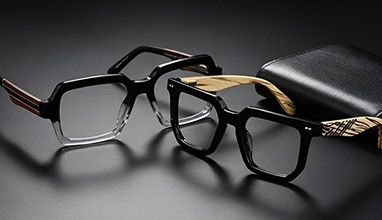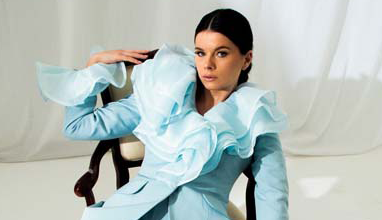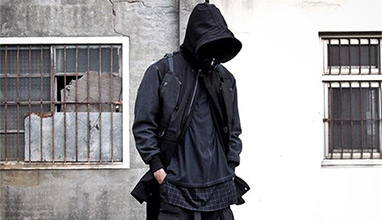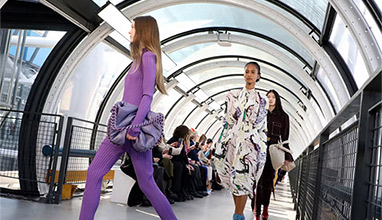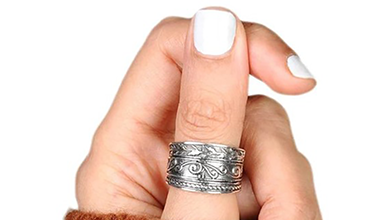Alexander Serafimoff illustrates his knitted dresses with colourful landscapes and animals
 Alexander Serafimoff is a russian designer who creates knitted dresses illustrated with colourful landscapes and animals. He uses "%100 natural" yarn (sheep's and llama's wool as well as cotton).
Alexander Serafimoff is a russian designer who creates knitted dresses illustrated with colourful landscapes and animals. He uses "%100 natural" yarn (sheep's and llama's wool as well as cotton).
"It definitely seems to me that nowadays the 100% organic yarn is not existing on sale. At present, if you see (at the label of yarn) an inscription "100%" you should realize that it's implying no more than 95%. The "hidden" rest (from 5% to even 10%) contains viscose, lavsan and so on -- "things" that make the knitwear made by "natural" yarn more "yielding springing" and less creased. Therefore I have to say that my "organic" knitwear is APPROXIMATELY organic..."
Alexander was Chief Specialist in a technical facility before ever thinking about fashion design.
Alexander told me "Throughout all of my 39 years, I have been carried away by almost innumerable things: history, literature, painting, ethnography, design, "serious" cinematography, even karate. Thanks to all that stuff, my poor cerebrum has been transformed into a kaleidoscope."
 So, how did Alexander begin designing clothing? It was just one more turn of the kaleidoscope.! "One time, my wife was preparing to knit herself a new dress. She got a German knitting magazine called Verena, and tried to choose something attractive. When I started to look at the illustrations, I suddenly discovered that all the images I pored over were strangely familiar to me. And I was reminded that a few days before, I had been turning over the pages of a huge book dedicated to the history of photography all over the world.
So, how did Alexander begin designing clothing? It was just one more turn of the kaleidoscope.! "One time, my wife was preparing to knit herself a new dress. She got a German knitting magazine called Verena, and tried to choose something attractive. When I started to look at the illustrations, I suddenly discovered that all the images I pored over were strangely familiar to me. And I was reminded that a few days before, I had been turning over the pages of a huge book dedicated to the history of photography all over the world.  One picture among others was one of the first color photos, showing an Alps resort around 1912. There were so many happy, rosy-faced skiers, of both sexes, standing under snowy spruces, dressed in
sweaters much like those I found in Verena. Men were decorated with manly crosses, rhomboid shapes, snow-flakes, with reindeers galloping from right shoulder to left. Women shamelessly tried to tempt men with flowers (of species unknown even to inveterate botanists), satin-stitched on their shoulders and breasts."
One picture among others was one of the first color photos, showing an Alps resort around 1912. There were so many happy, rosy-faced skiers, of both sexes, standing under snowy spruces, dressed in
sweaters much like those I found in Verena. Men were decorated with manly crosses, rhomboid shapes, snow-flakes, with reindeers galloping from right shoulder to left. Women shamelessly tried to tempt men with flowers (of species unknown even to inveterate botanists), satin-stitched on their shoulders and breasts."
"I was literally amazed! ! As time has passed through the ages, everything in our everyday world has evolved -- from town hall to iron, from blast furnace to button. Only the design of knitwear has resisted change! For me it turned out to be a real disclosure -- that nowhere was there such a conservative sphere of creative activity as the sphere of knitting design. And I could not help fighting against such a standstill, and keep devoutly fighting up to the current moment."




Alexander's design philosophy is what he describes as "a wee bit of a shock." His creations lie somewhere between that term "wee bit" and his early tendency to shock people.
"I am already beyond that initial creative period when shocking people is significant for an artist. On the other hand, I get irritated by traditions and any conservatism in one's creativeness. In other words, I am trying to overthrow the tedious dogmas of knitting, while avoiding the shocking "avant-garde" in my work.
And occupying an intermediate space like this, I feel there more freedom than anywhere else ! in this world.
Still, I pay respect to minimalists, though minimalism is rather tedious too: two sleeves, two lapels, the "singing lines of cutting," and that's all. Exhausting!"
 Not one to forget his engineering expertise, Alexander has invented a new kind of fastener. You can see it in many of the photographs. It's kind of a giant cloth zipper. Reinforced knit fabric loops replace traditional fasteners, and the wearer slips one loop into another to "zip up" a coat, dress, or whatever. Unfastening is swift. To use Alexander's catch phrase, "Unconnecting is lightning".
Not one to forget his engineering expertise, Alexander has invented a new kind of fastener. You can see it in many of the photographs. It's kind of a giant cloth zipper. Reinforced knit fabric loops replace traditional fasteners, and the wearer slips one loop into another to "zip up" a coat, dress, or whatever. Unfastening is swift. To use Alexander's catch phrase, "Unconnecting is lightning".
Hits: 9597 | Leave a comment
Tags:fashion, dresses, knite, landscapes, animals, Alexander Serafimoff, collection



